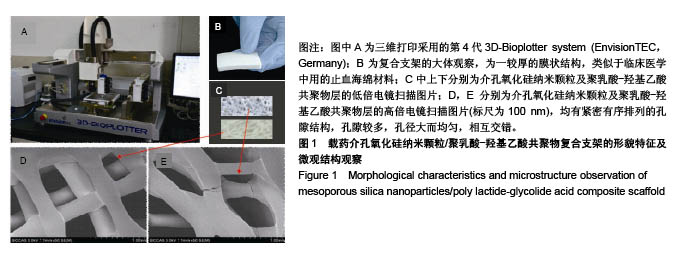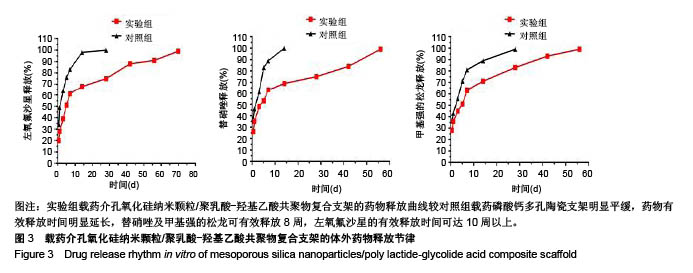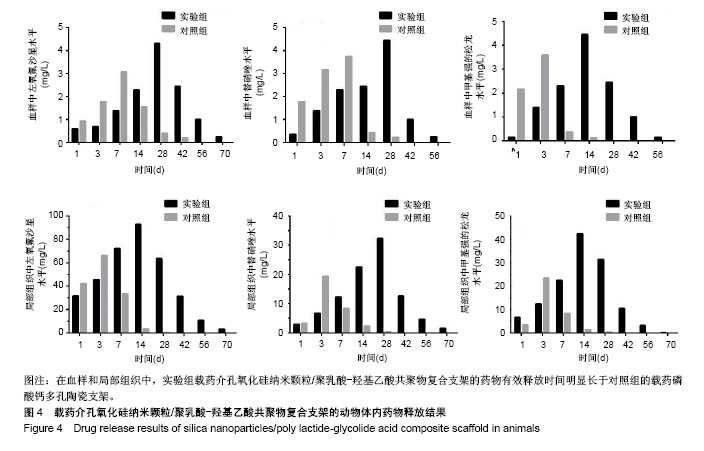中国组织工程研究 ›› 2019, Vol. 23 ›› Issue (18): 2858-2864.doi: 10.3969/j.issn.2095-4344.1670
• 药物控释材料 drug delivery materials • 上一篇 下一篇
多药缓释抗菌抗炎支架的制备与性能分析
吴建新1,罗 丹2,李 坤3,徐 宁4,叶晓健4
- 1上海长海医院虹口院区骨科,上海市 200081;2上海海军特色医学中心护理部,上海市 200052;3鄂州市中心医院骨科,湖北省鄂州市 436000;4上海长征医院脊柱微创中心,上海市 200003
Preparation and property analysis of drug-loaded sustained-release scaffold with antibacterial and anti-inflammatory roles
Wu Jianxin1, Luo Dan2, Li Kun3, Xu Ning4, Ye Xiaojian4
- 1Department of Orthopedics, Hongkou Branch of Changhai Hospital, Shanghai 200081, China; 2Department of Nursing, Shanghai Navy Medical Center, Shanghai 200052, China; 3Department of Orthopedics, Central Hospital of Ezhou, Ezhou 436000, Hubei Province, China; 4Spinal Minimally Invasive Center, Shanghai Changzheng Hospital, Shanghai 200003, China
摘要:
文章快速阅读:
.jpg)
文题释义:
三维打印技术:也被称为快速成型打印技术,是利用普通打印机的原理,将打印机和计算机连接起来,把原料装入机身,通过计算机的控制,用激光注射器将原料一层一层累积起来,最后将计算机上的蓝图变成实物。实验根据预先设计好的CAD模型,采用三维打印机交替打印介孔氧化硅纳米颗粒载药微球与聚乳酸-羟基乙酸共聚物层层叠加的多孔网络结构,最终得到膜状载药复合支架。
缓释载药支架载药方式:将多孔支架直接浸渍到药物溶液中,药物通过吸附至支架孔道,药物的释放过程为原位释放;先制备药物包覆微球,然后微球进一步吸附入支架内部,药物的释放与支架的降解及微球的缓释均有关,因此该方法能较好的延缓药物的释放,提高药物的有效释放时间,但由于该方法对局部的pH值影响较大,有可能对细菌生长起到一定的诱发作用;将药物直接与支架材料混合,匀浆直接制备出载药支架材料,载药缓释支架中药物释放节律主要由材料的降解节律控制。
背景:处理创伤局部软组织感染时,全身口服抗生素局部药物浓度较低,无法满足创伤局部抑菌的需要,局部喷洒抗生素粉末虽能临时获得一过性的高浓度,但难以取得较满意的抑菌效果,且高浓度药物对局部组织亦存在一定的破坏效应。
目的:开发一种能承载多药并有控释特性的载药缓释支架,用于创伤局部的抗菌抗炎治疗。
方法:将左氧氟沙星、替硝唑及甲基强的松龙混合溶液与介孔氧化硅纳米颗粒在负压吸引装置中混合,制备介孔氧化硅纳米颗粒载药微球;根据预先设计好的CAD模型,采用三维打印机交替打印介孔氧化硅纳米颗粒载药微球与聚乳酸-羟基乙酸共聚物层层叠加的多孔网络结构,最终得到膜状载药复合支架(实验组),同时采用药物浸滞法制备载3种药物的磷酸钙多孔陶瓷支架,作为对照,检测2组支架的载药率。将2组支架分别于成纤维细胞共培养,采用CCK-8法检测细胞增殖,评价支架的细胞毒性。将2组支架分别浸泡于PBS中,检测支架内药物体外释放规律。将2组支架分别敷于新西兰大白兔(解放军海军军医大学动物实验中心提供)软组织损伤部位,术后不同时间点检测肝肾功能及血样、创伤周围组织中的药物浓度。
结果与结论:①实验组支架中左氧氟沙星、替硝唑及甲基强的松龙的载药率分别为31.21%,22.14%和23.58%,对照组支架3种药物的载药率分别为19.44%,11.14%和9.32%;②2种载药支架上不同时间点的细胞增殖率均在80%以上,细胞毒性为1级;③在体外,对照组支架中的3种药物在第2周基本释放完全,实验组支架中左氧氟沙星释放可达10周,替硝唑及甲基强的松龙释放可达8周;④在体内,实验组血样与局部组织中的3种药物释放时间均长于对照组,药物有效释放时间可达10周以上;实验组支架对兔肝功能存在一过性的影响;⑤结果表明,采用三维打印技术成功制备的多药缓释支架,有望在创伤局部实现联合、高量及持续的局部抗菌及抗炎作用,有效应用于各类局部创伤的辅助治疗。
中图分类号:





.jpg)